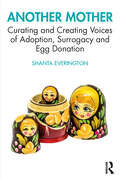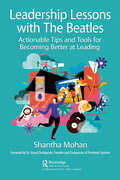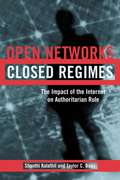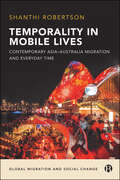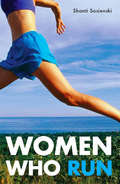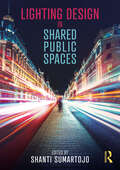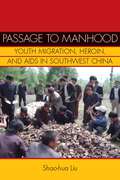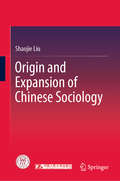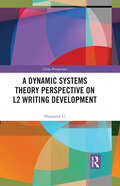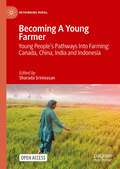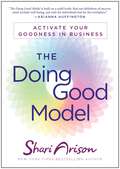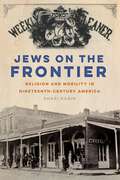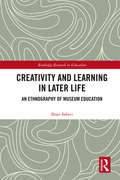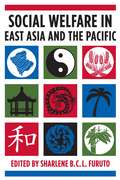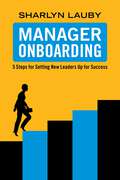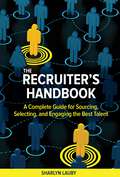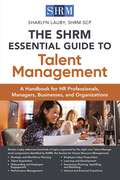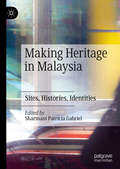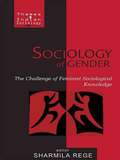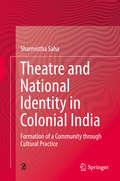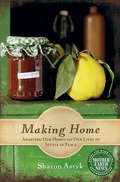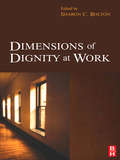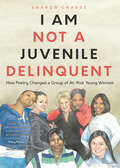- Table View
- List View
Another Mother: Curating and Creating Voices of Adoption, Surrogacy and Egg Donation
by Shanta EveringtonAnother Mother gives voice to women who become mothers through the routes of adoption, surrogacy and egg donation, and their silent partners – the birth mothers, surrogate mothers and egg donors – who make motherhood possible for them. Exploring experiences of motherhood beyond the biological mother raising her child, Everington draws on interviews and a range of interdisciplinary approaches to produce illuminating personal testimonies which expand our understanding of what it means to be a mother. The life writing narratives also examine the unique and hidden relationships that exist between adopters and birth mothers, egg donors and women who become mothers through egg donation, and surrogates and women who become mothers through surrogacy. Offering a fresh approach to life writing, using hybrid form encompassing edited interview, re-imagined scenes, poetry, personal essay and quotation collage, this topical book is recommended for anyone interested in motherhood studies, gender and women’s studies, life writing studies, the sociology of reproduction, creative non-fiction writing approaches, oral history and ethnography studies.
Leadership Lessons with The Beatles: Actionable Tips and Tools for Becoming Better at Leading
by Shantha Mohan"I can think of at least two good reasons for reading this delightful book. First, the leadership lessons that include the author’s story are as engaging as they are compelling. A brilliant student who studied engineering while becoming fascinated by leadership at an early age, Shantha Mohan jumps off the page in a way that makes you wish she was a friend living nearby. Second, it’s just plain fun to think about these old Beatles songs as leadership lessons." – Amy C. Edmondson, Professor, Harvard Business School; Author of The Fearless Organization: Creating Psychological Safety in the Workplace for Learning, Innovation, and Growth "Leadership Lessons with The Beatles is an extraordinary literary tour de force and a worthy addition to the catalog of must-have actionable business books. Shantha has written an accessible and practical book for aspiring leaders, existing leaders, and anyone interested in developing important skills for the 21st century economy. Of course, fans of The Beatles, like myself, will get a particular kick from Shantha’s approach to the subject matter. – Jonathan Reichental, Founder, Professor, and Author Leadership has gone through many changes in the last couple of decades. We have realized that outstanding leadership is not about being authoritarian and exercising control. It is not only about the intelligence quotient (IQ) but also about emotional intelligence. To be an exceptional leader, you need several essential skills, all of which you can learn. The skills are nuanced with emotional intelligence, which you can gain. This book is unique: the author weaves leadership ideas with the song titles of The Beatles, making this book fun, playful, thoughtful, and valuable. Each chapter is organized with the key message on a leadership attribute prompted by a Beatles’ song title, tips on becoming better on the topic, a practice suggestion, questions to ask yourself to think about the message, and resources for more reading. The author begins each chapter with how and why she chose the song and includes fun facts. It’s an engaging book that blends the words of perhaps the greatest rock band ever—The Beatles—with the basic principles for becoming a better leader.
Open Networks, Closed Regimes
by Taylor C. Boas Shanthi KalathilAs the Internet diffuses across the globe, many have come to believe that the technology poses an insurmountable threat to authoritarian rule. Grounded in the Internet's early libertarian culture and predicated on anecdotes pulled from diverse political climates, this conventional wisdom has informed the views of policymakers, business leaders, and media pundits alike. Yet few studies have sought to systematically analyze the exact ways in which Internet use may lay the basis for political change. In O pen Networks, Closed Regimes, the authors take a comprehensive look at how a broad range of societal and political actors in eight authoritarian and semi-authoritarian countries employ the Internet. Based on methodical assessment of evidence from these cases-China, Cuba, Singapore, Vietnam, Burma, the United Arab Emirates, Saudi Arabia, and Egypt-the study contends that the Internet is not necessarily a threat to authoritarian regimes.
Temporality in Mobile Lives: Contemporary Asia–Australia Migration and Everyday Time (Global Migration and Social Change)
by Shanthi RobertsonShanthi Robertson provides fresh perspectives on 21st-century migratory experiences in this innovative study of young Asian migrants’ lives in Australia. Exploring the aspirations and realities of transnational mobility, the book shows how migration has reshaped lived experiences of time for middle-class young people moving between Asia and the West for work, study and lifestyle opportunities. Through a new conceptual framework of ‘chronomobilities,’ which looks at 'time-regimes' and 'time-logics', Robertson demonstrates how migratory pathways have become far more complex than leaving one country for another, and can profoundly affect the temporalities of everyday life, from career pathways to intimate relationships. Drawing on extensive ethnographic material, Robertson deepens our understanding of the multifaceted relationship between migration and time.
Women Who Run
by Shanti SosienskiWomen run for all kinds of reasons -- for health, to ease the tension, for strength, to challenge themselves, to be social with friends, as professional athletes or the dream of being one, to turn their minds on, and to turn them off. Whether running a marathon, taking a quick jog around the neighborhood, or trying to reach the top of Pikes Peak, women of all ages and abilities have discovered running. In Women Who Run, a broad range of women, including Olympians, marathoners, ultra runners, young track phenoms, and recreational runners, talk about why they run, what drives them, and what continues to spark their interest in the sport. Whether it is Katharine Switzer, the first woman to run the Boston Marathon; Shirley Matson, "the fastest Grandma in the West" and a 64-year-old competitive speed walker; Sarah Reinersten, amputee competitive runner and spokesperson for athletes with disabilities; Louise Cooper, breast cancer survivor and finisher of the grueling 135-mile Badwater Marathon; or Kristin Armstrong, who found solace and camaraderie in running with other women post-divorce, all speak of the ways running has become necessary in their busy lives.
Lighting Design in Shared Public Spaces
by Shanti SumartojoThis book advocates an approach to lighting design that focuses on how people experience illumination. Lighting Design in Shared Public Spaces contextualises light, dark and lighting design within the settings, sensations, ideas and imaginaries that form our understandings of ourselves and the world around us. The chapters in this collection bring a new perspective to lighting design, arguing for an approach that addresses how lighting is experienced, understood and valued by people. Across a range of new case studies from Australia, Germany, Denmark, and the United Kingdom, the authors account for lighting design’s crucial role in shaping our dynamic and messy experiential worlds. With many turning to innovative ethnographic methodologies, they powerfully demonstrate how feelings of comfort, safety, security, vulnerability, care and well-being can configure in and through how people experience and manipulate light and dark. By focusing on how lighting is improvised, arranged, avoided and composed in relation to the people and things it acts upon, the book advances understandings of lighting design by showing how improved experiences of the built environment can result from more sensitive and context-specific illumination. The book is intended for social scientists who are interested in the lit or sensory world, as well as designers, architects, urban planners and others concerned with how the experience of light, dark and lighting might be both better understood and implemented in our shared public spaces.
Passage to Manhood: Youth Migration, Heroin, and AIDS in Southwest China
by Shao-Hua LiuPassage to Manhood addresses the intersection of modernity, heroin use, and HIV/AIDS as they are embodied in a new rite-of-passage among young men in the Sichuan province of southwestern China. Through a nuanced analysis of the Nuosu population, this book seeks to answer why the Nuosu has a disproportionately large number of opiate users and HIV positive individuals relative to others in Sichuan. By focusing on the experiences of Nuosu migrants and drug users, it shows how multiple modernities, individual yearnings, and societal resilience have become entwined in the Nuosu's calamitous encounter with the Chinese state and, after long suppression, their efforts at cultural reconstruction. This ethnography pits the Nuosu youths' adventures, as part of their passage to manhood, against the drastic social changes in their community and, more broadly, China over the last half century. It offers fascinating material for courses on migration, globalization, youth culture, public health, and development at both undergraduate and graduate levels.
Origin and Expansion of Chinese Sociology
by Shaojie LiuThis book reexamines Chinese sociology's point of departure and boundaries of western sociology from a new academic perspective, and offers a new definition of the essence and mission of sociology, drawing and critically reflecting on the ideological and theoretical theories of the classic sociologists. On this basis, it makes a careful study of the origin of Confucian classics and western sources of Chinese sociology and analyses the origin and evolution of Chinese sociology at the intersection of Chinese and western academic history. Further, it provides a deep and thorough discussion of the social theories of Chinese sociology pioneers and founders (such as Fu Yan, Youwei Kang, and Qichao Liang) and comments on Shuming Liang’s sociological theory, which emphasizes the Chinese culture and tradition as well as the particularity of the Chinese social structure. In addition, it also offers an in-depth analysis of Xiaotong Fei’s advocacy of the idea of expanding the traditional boundaries of sociology in his later years. With regard to promoting the development of a new Chinese sociology, the book is particularly important in terms of expanding academic research and promoting discipline construction.
A Dynamic Systems Theory Perspective on L2 Writing Development (China Perspectives)
by Shaopeng LiFrom the perspective of empirical complex dynamic systems, this book investigates the complex and nonlinear process of L2 writing centering on three linguistic aspects of L2 writing development: vocabulary, syntax, and discourse.Combining dynamic systems theory, variation analysis, as well as data and cases studies from Chinese EFL learners’ writing, the book critically engages with the heated discussion on dynamic patterns of L2 writing development that focus heavily on the linguistic dimensions of complexity, accuracy, and fluency. The author expands the scope of the research by integrating both linguistic and functional dimensions of L2 output and examines the interaction and co-development of these dimensions. This framework helps delineate a full picture of individual learners’ L2 writing dynamic patterns across all components of their communicative repertoire. The research findings suggest the developmental path of writing system for each EFL learner may differ, which is influenced by their different learning characteristics and learning environments in China.The title will appeal to scholars interested in applied linguistics and second language acquisition. Suggestions on pedagogy and language learning advanced in the book will also make it a useful read for L2 language learner and TESOL and TEFL teachers.
Becoming A Young Farmer: Young People’s Pathways Into Farming: Canada, China, India and Indonesia (Rethinking Rural)
by Sharada SrinivasanThis open access book is based on a multi-country collaborative research project focussing on Canada, China, India, and Indonesia.It responds directly and concretely to concerns about the generational sustainability of smallholder farming worldwide– reflected in the current UN Decade of Family Farming. Drawing on research that asks how (some) young people continue to pursue a (future) livelihood in farming, the book uses the life-course perspective and privileges voices of young farmers to show that movement away from farming such as time spent in education, migration and non-farm work does not exclude eventual farming futures.The book will be of interest to scholars and students of agrarian studies, anthropology, development studies, gender studies, human geography, rural sociology, and youth studies.
The Doing Good Model: Activate Your Goodness in Business
by Shari ArisonThere is now proof that business and philanthropy form a powerful platform for positive change. Shari Arison has shown this through her leadership in over three decades of philanthropy and 15 years of running her own global business, the Arison Group. In her previous New York Times bestseller, Activate Your Goodness, Shari revealed the ways doing good enriches the lives of individuals and those around them. Now, in The Doing Good Model, Shari's vision and insights have been applied to the corporate world to illustrate how everyone benefits when companies value people and the planet alongside profit. Learning about the 13 values within The Doing Good Model will enable business owners to rethink their impact on every level, from the individual, all the way through to our collective well-being. The Doing Good Model is a guide that will enable you to infuse your business with the power of doing good. And more than that, it's a call to action for business owners, leaders, and employees in all industries across the world to become agents for change. Companies of any size can benefit from Shari's vision. Her sustainable values-based business model can easily be introduced and implemented in any organization. It's time to revitalize modern business for the good of humanity. Let The Doing Good Model open your eyes and become a catalyst for corporate transformation.
Jews on the Frontier: Religion and Mobility in Nineteenth-Century America (North American Religions)
by Shari RabinNational Jewish Book Award Winner: An &“enlightening&” history of how Jews forged their own religious culture as they ventured into the American wilderness (Choice).Finalist, 2017 Sami Rohr Prize for Jewish Literature, presented by the Jewish Book CouncilJews on the Frontier offers a religious history that begins in an unexpected place: on the road. Shari Rabin recounts the journey of Jewish people as they left Eastern cities and ventured into the American West and South during the nineteenth century. It brings to life the successes and obstacles of these travels, from the unprecedented economic opportunities to the anonymity and loneliness that complicated the many legal obligations of traditional Jewish life. Without government-supported communities or reliable authorities, where could one procure kosher meat? Alone in the American wilderness, how could one find nine co-religionists for a minyan (prayer quorum)? Without identity documents, how could one really know that someone was Jewish? Rabin argues that Jewish mobility during this time was pivotal to the development of American Judaism. In the absence of key institutions like synagogues or charitable organizations which had played such a pivotal role in assimilating East Coast immigrants, ordinary Jews on the frontier created religious life from scratch, expanding and transforming Jewish thought and practice.Jews on the Frontier vividly recounts the story of a neglected era in American Jewish history, offering a new interpretation of American religions, rooted not in congregations or denominations but in the politics and experiences of being on the move. This book shows that by focusing on everyday people, we gain a more complete view of how American religion has taken shape. This book follows a group of dynamic and diverse individuals as they searched for resources for stability, certainty, and identity in a nation where there was little to be found. &“Scholars of immigration have toiled for years on the question of how mobility affects nationalities and group identities alike…Rabin gives this framework an interesting twist by investigating mobility&’s influence on religion.&” ― American Jewish Archives Journal
Creativity and Learning in Later Life: An Ethnography of Museum Education (Routledge Research in Education)
by Shari SabetiCreativity and Learning in Later Life examines how processes such as ‘creativity’ and ‘inspiration’ are experienced by writers who engage with the visual arts, and questions how age is perceived in relation to these processes. The author’s careful analysis challenges many of the assumptions on which museum education currently operates, contributing to wider debates surrounding the value of arts and cultural heritage education. Containing detailed descriptions of museum tours, viewers’ engagements with specific artworks, and the processes of creative writing and editing that result from such encounters, the book draws on a ground-breaking study to challenge the way in which the value of education and creative activity for older adult learners has been conceptualized in existing literature. It also demonstrates how learners adapt and subvert the intended pedagogies to suit their own needs and accommodate their ageing selves. Drawing on a spectrum of disciplines including education, anthropology, art history, sociology, museum studies and the practice and theory of creative writing, this book will be of interest to academics, postgraduate students, and researchers in a range of fields, as well museum practitioners, creative writing teachers and those working in adult and community education settings.
Creating a World That Works for All
by Sharif M. Abdullah"We are in deep trouble," writes Sharif Abdullah. "We live a world that works for only a few." The problem, Abdullah asserts, is exlusivity: "I am separate." By practicing exclusivity, he maintains, we have created a soul-starved society. We suffer, both personally and as a society, from complex, interlocking so intense that they create a deep sense of emptiness in all of us. But there is hope. Abdullah shows how we can change our world by changing our consciousness. We can actually put an end these complex problems if we reject exclusivity in favor of inclusivity. We must turn from a mentality that disconnects us and instead embrace the goals of restoring balance to the earth and building community with all other people. In Creating a World That Works for All, Abdullah provides a practical blueprint for that change. Abdullah makes it clear that there are no bad guys to blame: we are all equally responsible for the current state of our world. We each have created it, and we each have equal power to change it. Abdullah offers three criteria for creating a world that works for all: 1. The Criteria of Enoughness: Everyone has enough, even though not everyone shares resources equally 2. The Criteria of Exchangeability: Trading places would be okay 3. The Criteria of Common Benefit: The system is designed and intended to benefit all In order to meet these criteria, Abdullah shows us how to let go of old theories and ideas, so we can clearly see our current problems and possible solutions. And he shows us how to create new stories that explain and define the new behaviors that make cultural changes possible.
Social Welfare in East Asia and the Pacific
by Sharlene B. C. L. FurutoIn this singular collection, indigenous experts describe the social welfare systems of fifteen East Asian and Pacific Island nations and locales. Vastly understudied, these lands offer key insight into the successes and failures of Western and native approaches to social work, suggesting new directions for practice and research in both local and global contexts.Combining international experiences and professional knowledge, contributors illuminate the role of history and culture in shaping the social welfare systems of Cambodia, China, Hong Kong (SAR, China), Indonesia, Malaysia, the Micronesian region (including the Federated States of Micronesia, Guam [Unincorporated Territory, U.S.A.], Marshall Islands, Northern Mariana Islands [Commonwealth, U.S.A.], and Palau), Samoa and American Samoa (Unincorporated Territory, U.S.A.), South Korea, Taiwan, and Thailand. The contributors link the values and issues that concern populaces most to the development of social work practice, policy, and research. Sharlene B. C. L. Furuto then conducts a comparative analysis of the essays including their data and social service programs, highlighting the similarities and differences between the evolution of social welfare in these nations and locales. She contrasts their indigenous approaches, the responses of governments and NGOs to social issues, the availability of social work education, as well as API models, paradigms, and templates, and the overall status of the social work profession. Furuto also adds a chapter comparing the distinct social welfare systems of Samoa and American Samoa. The only volume to focus exclusively on social welfare in East Asia and the Pacific, this anthology holds immense value for practitioners and researchers eager for global perspectives.
Manager Onboarding: 5 Steps for Setting New Leaders Up for Success
by Sharlyn LaubyManagers play a vital role in onboarding but rarely receive onboarding themselves. Manager Onboarding offers HR and business leaders a practical roadmap for creating structured onboarding programs specifically for managers, whether newly hired or recently promoted.While onboarding touches nearly every part of the employee lifecycle, this book zeroes in on the early-stage support managers need to succeed. From recruiting and training to coaching and performance management, managers must lead confidently and yet often lack the same foundation we give new hires. Filled with real-world examples, stories and actionable advice, this book blends just enough theory with proven practices to help organizations build programs that elevate leadership from day one.
The Recruiter’s Handbook: A Complete Guide for Sourcing, Selecting, and Engaging the Best Talent
by Sharlyn LaubyEffective recruiting is more than filling jobs. It's about building trust and shaping organizational culture. The Recruiter's Handbook offers a comprehensive, step-by-step guide to the entire recruiting process, written by HR Bartender's Sharlyn Lauby, SHRM-SCP. With expert insights, tools and proven strategies, the book helps HR and talent acquisition professionals shorten learning curves, avoid legal missteps and create meaningful candidate experiences. It also includes specialized guidance on inclusive hiring practices, recruiting veterans and ex-offenders and building mentorship and internship programs. Ideal for both new and experienced recruiters, this practical guide is a trusted resource for building stronger teams and better hiring outcomes.
The SHRM Essential Guide to Talent Management: A Handbook for HR Professionals, Managers, Businesses, and Organizations
by Sharlyn LaubyFinding and keeping great talent is a constant business challenge and HR's top priority. The SHRM Essential Guide to Talent Management is a practical desk reference for HR professionals seeking real-world solutions to the full range of talent issues. Written by Sharlyn Lauby, this guide covers hundreds of topics, organized around SHRM's eight core talent management components:· Strategic and Workforce Planning· Talent Acquisition· Onboarding and Employee Engagement· Performance Management· Employee Value Proposition· Learning and Development· Succession Planning, Upskilling, and Reskilling· Internal and External TransitionsPacked with insights, tools, and best practices, the book offers fast, effective help when you're facing hiring, coaching, or retention hurdles.A must-have resource for busy HR practitioners, it keeps you aligned with current trends while providing clear direction when it matters most.
Kill the Cowboy: A Battle of Mythology in the New West
by Sharman Apt RussellOn ranching, environmentalism, and change -- life and thought in the West, seen through the eyes of some of the players.
Making Heritage in Malaysia: Sites, Histories, Identities
by Sharmani Patricia GabrielThis book offers a scholarly perspective on heritage as a discourse, concept and lived experience in Malaysia. It argues that heritage is not a received narrative but a construct in the making. Starting with alternative ways of “museumising” heritage, the book then addresses a broad range of issues involving multicultural and folklore heritage, the small town, nostalgia and the environment, and transnationalism and cosmopolitanism. In so doing it delivers an intervention in received ways of talking about and “doing” heritage in academic as well as state and public discourse in Malaysia, which are largely dominated by perspectives that do not sufficiently engage with the cultural complexities and sociopolitical implications of heritage. The book also critically explores the politics and dynamics of heritage production in Malaysia to contest “Malaysian heritage” as a stable narrative, exploring both its cogency and contingency, and builds on a deep engagement with a non-western society in the service of “provincialising” critical heritage studies, with the broader goal of contributing to Malaysian studies.
Sociology of Gender
by Sharmila RegeThis invaluable reader maps the contributions made by feminist scholars towards engendering mainstream sociological discourse in India. It covers a broad range of issues relating to the lifespan of women in different social institutions such as the family, school and the workplace. This book is one of the Indian Sociological Society: Golden Jubilee Volumes.
Theatre and National Identity in Colonial India: Formation Of A Community Through Cultural Practice
by Sharmistha SahaThis book critically engages with the study of theatre and performance in colonial India, and relates it with colonial (and postcolonial) discussions on experience, freedom, institution-building, modernity, nation/subject not only as concepts but also as philosophical queries. It opens up with the discourse around ‘Indian theatre’ that was started by the orientalists in the late 18th century, and which continued till much later. The study specifically focuses on the two major urban centres of colonial India: Bombay and Calcutta of the 19th and early 20th centuries. It discusses different cultural practices in colonial India, including the initiation of ‘Indian theatre’ practices, which resulted in many forms of colonial-native ‘theatre’ by the 19th century; the challenges to this dominant discourse from the ‘swadeshi jatra’ (national jatra/theatre) in Bengal, which drew upon earlier folk and religious traditions and was used as a tool by the nationalist movement; and the Indian People’s Theatre Association (IPTA) that functioned from Bombay around the 1940s, which focused on the creation of one national subject – that of the ‘Indian’. The author contextualizes the relevance of the concept of ‘Indian theatre’ in today’s political atmosphere. She also critically analyses the post-Independence Drama Seminar organized by the Sangeet Natak Akademi in 1956 and its relevance to the subsequent organization of ‘Indian theatre’. Many theatre personalities who emerged as faces of smaller theatre committees were part of the seminar which envisioned a national cultural body. This book is an important contribution to the field and is of interest to researchers and students of cultural studies, especially Theatre and Performance Studies, and South Asian Studies.
Making Home: Adapting Our Homes and Our Lives to Settle in Place (Mother Earth News Books for Wiser Living)
by Sharon Astyk&“Shows us why the actions that prepare us for emergencies and energy descent are the right things to do no matter what the future brings.&” —Toby Hemenway, author of Gaia&’s Garden Other books tell us how to live the good life—but you might have to win the lottery to do it. Making Home is about improving life with the real people around us and the resources we already have. While encouraging us to be more resilient in the face of hard times, author Sharon Astyk also points out the beauty, grace, and elegance that result, because getting the most out of everything we use is a way of transforming our lives into something much more fulfilling. Written from the perspective of a family who has already made this transition, Making Home shows readers how to turn the challenge of living with less into settling for more—more happiness, more security, and more peace of mind. Learn simple but effective strategies to: · Save money on everything from heating and cooling to refrigeration, laundry, water, sanitation, cooking, and cleaning · Create a stronger, more resilient family · Preserve more for future generations We must make fundamental changes to our way of life in the face of ongoing economic crisis and energy depletion. Making Home takes the fear out of this prospect, and invites us to embrace a simpler, more abundant reality. &“Americans are born to be transient—Sharon Astyk has the prescription for dealing with that genetic disease, and building a healthy nativeness into our lives.&” —Bill McKibben, New York Times–bestselling author &“Exhaustively researched and compassionately delivered.&” —Harriet Fasenfest, author of A Householder&’s Guide to the Universe
Dimensions of Dignity at Work
by Sharon C. BoltonWhat is dignity in and at work? How is it experienced differently by different groups of working people?Are there enduring divisions of dignity: unequal access to what is accepted to be a fundamental human right?How can we ensure that continued opportunities are available for the creation, maintenance and restoration of dignity at work?This edited collection of papers investigates the concept of dignity and what it means to people in their working lives: how we are perceived and valued as people in the workplace.Contributors to over a century of social and organizational analysis have talked about dignity at work, but the discussion has tended to take place under headings such as citizenship, satisfaction, mutuality, pride in work, responsible autonomy and ontological security, or to focus on mismanagement, over-long hours, a poor working environment, workplace bullying and harassment as the central facilitator of indignity at work.Dignity in and at work is a far more complex phenomenon than these representations would suggest. Neither is it enough to suggest that equal opportunity, work life balance and anti-bullying policies restore dignity to work, valuable interventions though they are in themselves. The papers featured in this edited collection suggest that we see dignity reordered and experienced in different ways depending on our own circumstances and viewpoints.
I Am Not a Juvenile Delinquent: How Poetry Changed a Group of At-Risk Young Women
by Sharon ChardeThe #metoo movement, particularly the horrific Larry Nasser abuse, shows with frightening clarity the vulnerability of young women to male predators; all the Touchtone girls I encountered suffered similar or worse fates. The book is a pilgrimage, a quest story, divided into five sections. Part I explores the authors first year at the facility, the difficulty and eventual success of establishing my group in such a chaotic and contradictory culture. It recreates their writing sessions, and features the vivid, dramatic personalities of the girls who participated as well as the steep learning curve on which she found herself daily. Part II moves swiftly through the trials and victories between the first and last years, and offers brief profiles of three of the residents who held special resonance to the author. During this time she published an award-winning anthology of poems by the girls, a NYC filmmaker created a documentary film, many readings and public performances took place and received several awards for the program. Part III tells of the joint venture with The Hotchkiss School, revealing the differences yet common ground between the two groups of girls.
